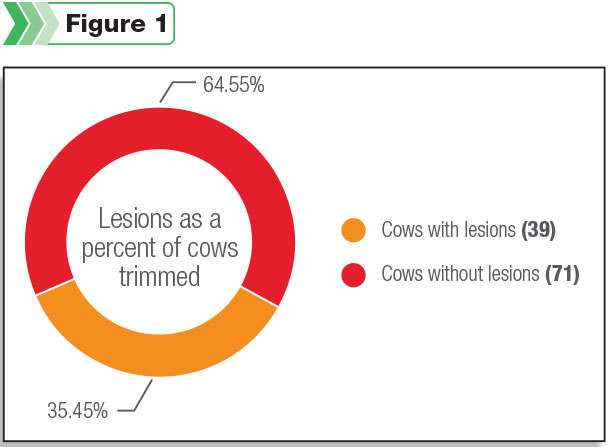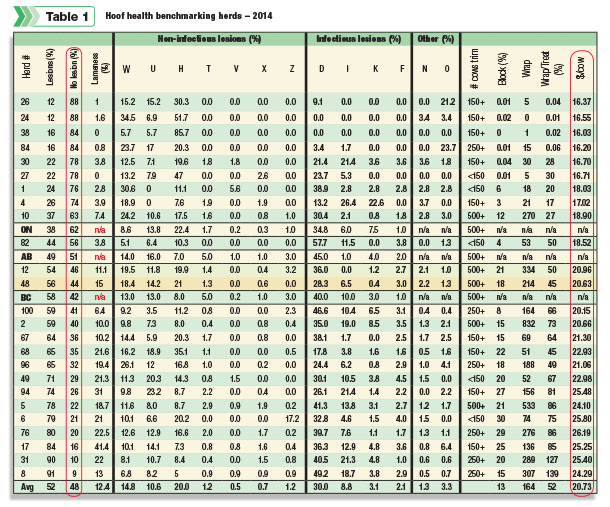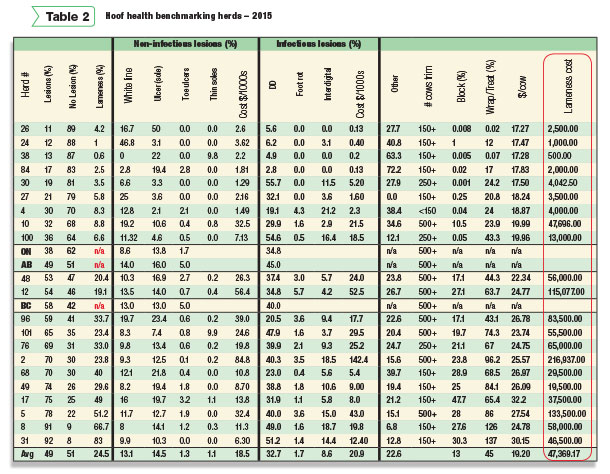One of the major changes in my business over the years is the type of records I keep on trim day and how I record this data, but even more important is how and with whom I share these records. When dairy producers put this information to work, they can make great strides to reduce lameness.
Keeping records
Chuteside computers have helped my clients get the most out of trim day. Yes, the first priority is to fix the lame cow or do a proper maintenance trim at the right time to prevent lameness, but taking the time to record what I am seeing is just as valuable.
Tracking trim-day results with computer programs have made it easier to pinpoint problem areas in the herd that are causing lameness. Now, we can quickly and easily monitor hoof health by month, pen or stage of lactation and see where there may be a bottleneck that is causing lameness. We can begin to track and monitor trends in hoof health.
Today, most dairies are not on a whole-herd trim schedule but rather regular weekly, bimonthly or monthly schedules where a small sample of the herd is trimmed either to fix a lame cow or a routine trim. Although these individual trim days provide a small snapshot, it’s not a true picture of what’s going on in the whole herd.
In many cases, all the herd’s lame cows don’t even make the trim list, so we need to monitor results over time and look for trends from trim-day results. That is why I tend to look at the percentage of cows with no lesions on the trim-day summary report.
Since I began using the hoof tracking software in 2008, I have found you will usually start seeing an increase in the percentage of cows with lesions before a spike in lameness and vice versa (Figure 1).

The lesions may be an increase in sole or white-line hemorrhages but not severe enough to be an ulcer or white-line fissure. It could be a trend of chronic digital dermatitis (DD) cows with small ulcerated lesions, which indicates footbath protocols have not been followed or need to be adjusted.
The team approach
All of this record-keeping and monitoring is great, but if it’s just the hoof trimmer looking at the reports, not much will happen. Also, a report that is left in the farm office can quickly get covered up by magazines, sales flyers and other “important papers” and will do nothing to help improve hoof health in the herd.
Shortly after incorporating computer records into my business, I shared some monthly and quarterly reports with a client’s nutritionist and asked if they would find it helpful.
After that, a true team approach started to happen; a lot of my clients saw hoof health improvements. We were now all on the same page on where the herd was and where we wanted to go. It has also helped keep us all accountable with each other.
Sharing reports regularly with all industry partners involved on the dairy has improved communication and the team approach concept for many of my clients. Some trimmers hate when the vet or nutritionist stops by the trim chute, but I love it. We can find out so much with a five-minute conversation with the cost of only one less cow that hour.
Each of us are only on the farm for a small part of each month. Every day, employees and managers are there and may miss small changes that gradually develop into a major problem. When we are all on the same page and communicating with each other, we can prevent the abnormal from becoming normal when it comes to lameness.
Benchmarking
A few years ago, clients started asking me how their herd compared to others in terms of lameness, so I starting offering them a benchmarking report. Table 1 shows how I first benchmarked my herds with a ranking of cows with no lesions.

I did not use incidence of lameness as I believe too many lame cows are missed on trim day to be accurate on the trim report. I also put the average price per cow to show that when trim day is just used to fix lame cows and trim long toes, the cost per cow rises dramatically.
I simplify the report to just show the main lameness-causing lesions, like ulcers, white-line disease and infectious lesions, and then I add in the cost of lameness beyond just cost of trimming based on infectious and non-infectious lesions (Table 2).
Calculating the cost of lameness
Putting a cost to the lesion makes for better conversations on investing in changes to improve lameness. For example, if a client had an improper footbath or insufficient footbath protocol that was costing the dairy $195,000 of lost annual income due to DD lesions, it is easier to talk about investing in a proper footbath and increasing the frequency in footbathing.
It may even justify the cost to put an extra person in the parlor a couple times a week to look for DD lesions and then sort these cows to be topically treated.
Set SMART hoof health goals
Steve Roch of Acer Consulting says, “We need to set goals that are SMART: specific, measurable (with numbers), attainable and time-bound.”
I’ve been trying to bring this approach to my trim business. When a problem is detected by monitoring trim-day reports, it is brought to the attention of the dairy manager, staff and nutritionist, and I am trying to get vets on board too.
We implement a change and monitor results, sometimes by making the change in one group and keeping a control group to see how much of an improvement is attained. This is especially useful with infectious lesions such as DD, where we can monitor and measure changes in relation to a product, frequency, placement or type of bath.
It’s also important to acknowledge when things are going well and improvement has been achieved, especially to employees. As farm advisers use the SMART approach, we can help our clients achieve zero lameness: more days with cows showing no signs of lameness than days with a lame cow.








